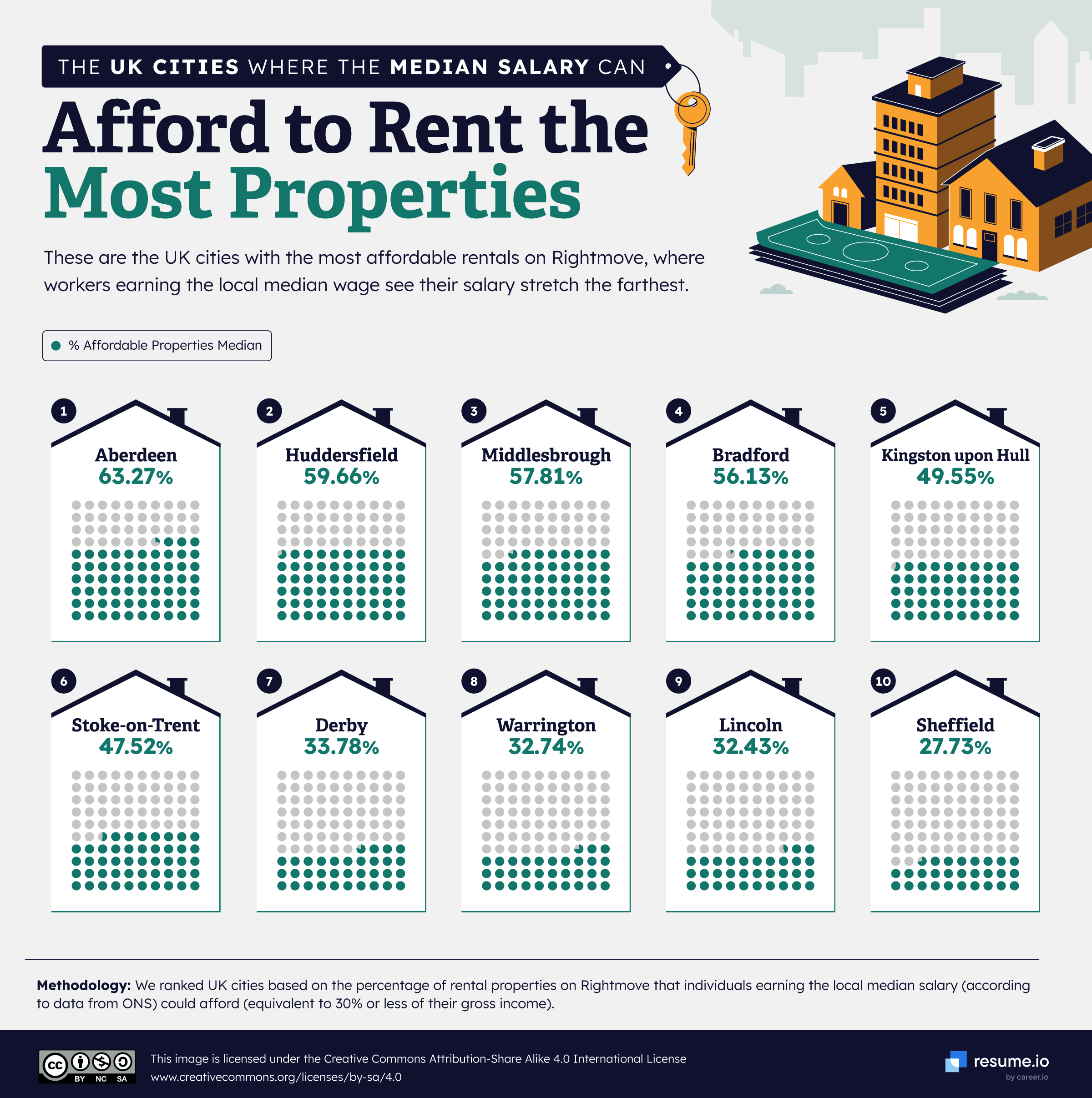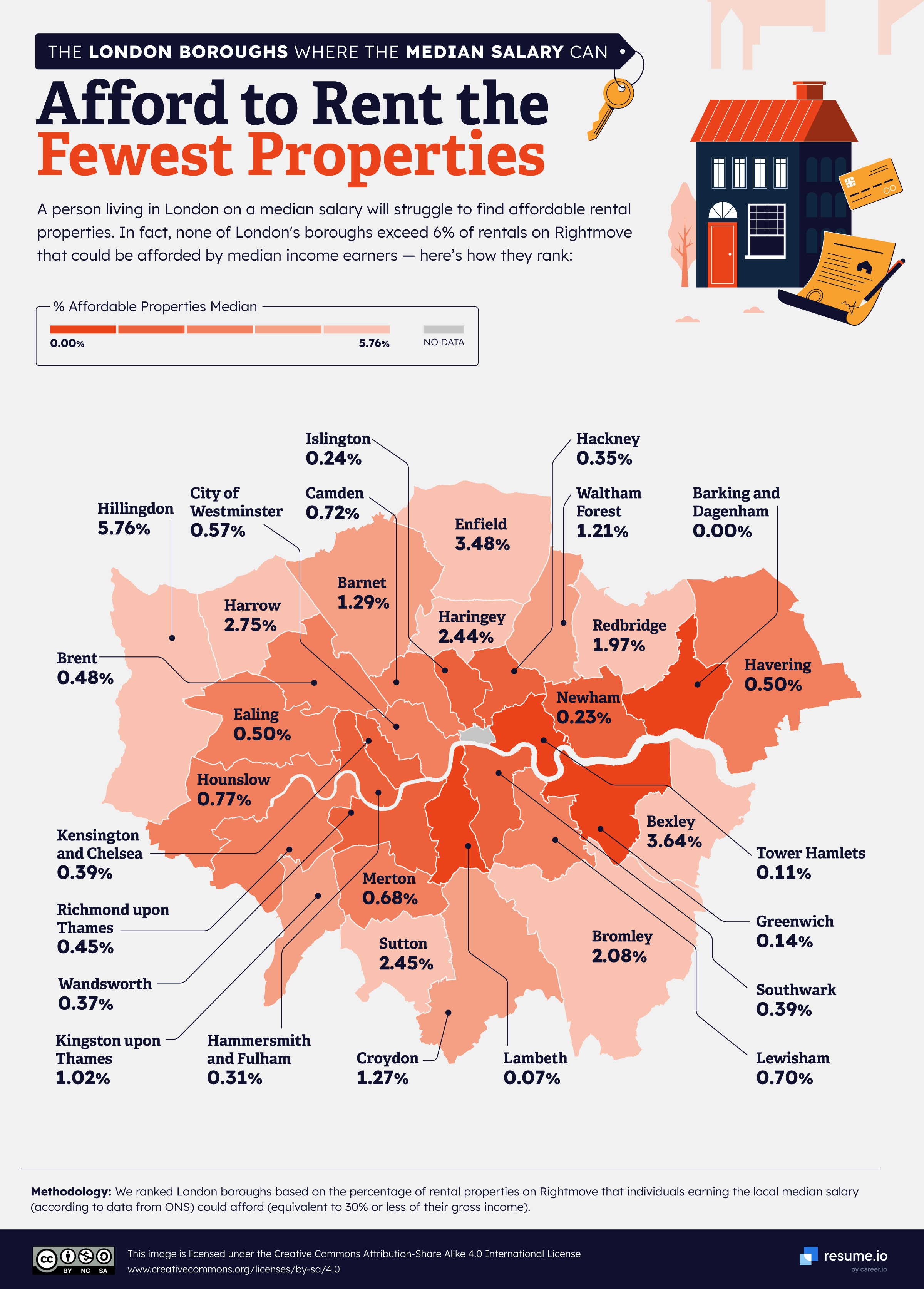Landlords have raised the average price of renting a UK home by 9.2% over the last year, with tenants charged an extra £104 per month on average. But average earnings in the UK rose by just 3.0% over the same period, against a spiralling cost of living. While the cost of running a rental property has also increased, 59% of landlords admit to raising prices to keep up with local market trends.
Some will feel the rent hikes more than others. Rent has risen the fastest in London, which is already the most expensive place to live. However, Scotland has seen an average increase of 10.5% up to March 2024, next to 9.1% in England and 9.0% in Wales. Since the Office for National Statistics (ONS) considers ‘affordable’ rent to be 30% or less of a household’s gross income, in each case these figures need to be balanced with the latest salary levels in local areas.
To get a closer idea of how rent increases affect people around the UK, Resume.io used local salary figures to find out which major cities and London boroughs have the most and fewest affordable homes available to rent.
What we did
We used Office for National Statistics (ONS) data to find the gross median annual salaries for every major UK city with a population above 100,000 and every London borough. Then, we calculated the maximum affordable rent for each location based on 30% of each location's gross median income. Next, we found the monthly rent price of every rental in these locations from Rightmove.co.uk and calculated the percentage of properties with affordable rental prices.
Key findings
- Aberdeen is the major UK city with the highest proportion of affordable rentals on the average local salary: 63.27%.
- Slough (0.66%) and London (0.69%) have the fewest affordable rental properties in the UK.
- There are zero affordable rental properties in Barking and Dagenham — the lowest figure for any London borough.
- The London borough with the most affordable rentals is Hillingdon, where 5.76% are available on 30% of the average local salary.
The UK cities where the median salary can afford to rent the most and fewest properties
ONS figures show that Scotland has seen the highest rent hikes over the past year, but we found that Aberdeen is the major UK city with the most affordable properties. Some 63.27% of available rentals in Aberdeen cost under 30% of the average local salary. The remainder of the top ten cities for affordability are in the north of England, with a notable concentration in Yorkshire.

In addition to being the most affordable place to rent, Aberdeen is the cheapest city for first-time buyers, according to Rightmove. Aberdeen has a vast — though decreasing — stock of empty homes, partly due to the fallout from the oil crash and Covid-19. Since the pandemic, housing authorities have seen a renewed interest in house rentals, as opposed to flats and apartments.
Scotland is also represented among the ten cities with the fewest affordable rentals (below). Just 2.05% of properties in Edinburgh meet the ONS criteria for affordability as we’ve interpreted it, making it the seventh least affordable city in the UK. With the exception of York, the remainder of the top ten is towards the south of England, with London (0.69%) and nearby Slough (0.66%) having the fewest affordable rentals of all.

Economic inequality is a pressing issue across much of the UK, particularly in London, where the 20% highest earners earn at least 2.5 times more than the 20% lowest earners. This situation can lead to artificially inflated rents and gentrification in traditionally working-class areas of the city.
This has a knock-on effect on commuter belt areas such as Slough, which has experienced a particularly intense “wave of new tenants” in the wake of the post-pandemic “London Exodus,” according to local property developers SevenCapital.
The London boroughs where the median salary can afford to rent the fewest properties
The affordability of rental homes varies greatly within London, depending on which of the 32 boroughs are considered. We looked at wage levels and rental costs specific to each borough and found that these factors carry different weights from borough to borough.
For example, the average salary in Bexley is 12.5% higher than that of Enfield, but they have a near identical rate of affordable rentals (3.64% and 3.48%), indicating the lower cost of rentals in Enfield. Meanwhile, average salaries in Bexley are almost the same as those in Lambeth — where just 0.07% of housing is considered affordable.

The borough with the most affordable housing compared to wages is Hillingdon (5.76%), although there are 19 boroughs with a higher average wage. However, the borough with the least affordable housing altogether is also the borough with the lowest average salary: Barking and Dagenham, where we found precisely zero rental properties available for 30% of the local wage.
The borough of Barking and Dagenham has built 20% of London’s affordable housing since Covid, according to local council leader Darren Rodwell. The area has a high birthrate and increasing claims for housing benefits — suggesting that however tough it may be to get by in Barking, it remains more appealing than moving to a more expensive area.
How many properties can you rent in different cities with the median UK salary?
Our calculations above are all based on the local wage rates of the respective locations. But for our final insight, we looked at how much affordable housing there is across the UK’s most populous cities based on the national average salary, which we determined to be £34,963 using ONS figures. On this salary, any rent up to £874 per month is considered ‘affordable.’

Based on these parameters, Liverpool is the most affordable big city in the UK, with 36.10% of available rentals costing under 30% of the national average salary. By contrast, Manchester — just a few miles away — offers only 4.30% of its rentals at this rate. Manchester has become a prime choice for both businesses and individuals looking to escape London. The population of Manchester rose by 9.7% between 2013-2023 in symbiosis with the arrival of high-paying companies and an ever-expanding cultural scene.
Dead End Streets
High interest rates and house prices, along with low wages (compared in absolute terms or to the cost of living), have made buying a house unaffordable without a sizable deposit for many ordinary workers in the UK. But spiralling rents have made it impossible to save towards a deposit, resulting in their monthly housing budget going to a landlord rather than securing their own future.
Meanwhile, says Shelter's chief executive Polly Neate, this demand for rentals means that landlords are able to “hike up the rent, safe in the knowledge that if their tenants can't pay, they can issue a no-fault eviction with just two months' notice and get a new tenant at a higher rent.” As our study illustrates, it may be possible for some to relocate to find a better deal on housing — but without addressing the fundamental issues, this may just be moving the problem around.
Methodology
We ranked major UK cities and London boroughs based on the percentage of rental properties on the market that individuals earning the local median salary could afford.
We built a list of major UK cities with a population above 100,000 and every London borough before gathering the gross median annual salaries for these locations from the ONS "Earnings and Hours Worked" dataset.
We then calculated the maximum affordable rent for each location based on 30% of each location's gross median income. Rent affordability calculations are based on ONS standards, whereby "a property (is) deemed "affordable" if a household would spend the equivalent of 30% or less of their gross income on rent."
Next, we built a list of all rental properties for each location and their monthly rent prices from Rightmove.co.uk (excluding house shares, retirement homes and student accommodation).
Lastly, we calculated the percentage of properties in each location with affordable rental prices. The full study was completed in August 2024.




